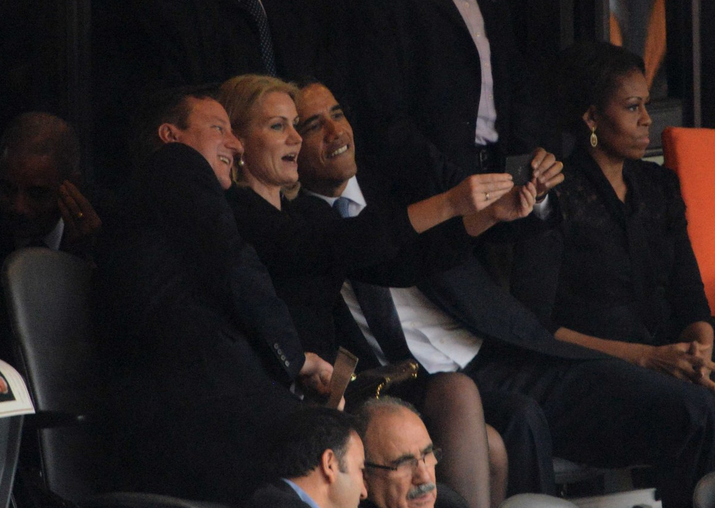A picture is worth a thousand words, but a presidential selfie? Priceless.
You’re selfie-ing…
I bet you think this moment’s about you
You’re selfie-ing
I bet you think this moment’s about you, don’t you #dontyou?
It’s truly the year of the “selfie,” the self portrait of today’s wired world. Ranging from silly to narcissistic to contemplative, the selfie is changing how we understand and communicate information about ourselves and our friends/family.
Over 100M photos have been tagged with the hashtag “me” or “selfie” on Twitter and Instagram, and the Oxford English Dictionary recently named “selfie” 2013’s word of the year.
It’s important to realize that the selfie is not entirely a new phenomenon. Van Gogh painted self portraits and Andy Warhol popularized the self photo in the 70s, but it’s really been the smartphone, and specifically, the iPhone 4 with its front-facing camera, that truly popularized the selfie movement. What’s most interesting to me though, is not this desire to autobiographically document our lives – humans have always had that need – it’s our growing incessant need to share these images and the fact that our self worth is now measured and validated by other people’s approval of these images.
It’s high time for a discussion around selfies, sharing and general social media etiquette — and who better to force that discussion than the leader of the free world himself, demonstrating his own very complicated relationship with tech?
Earlier this week, President Obama was snapped taking a selfie with British Prime Minister David Cameron and Danish Prime Minister Helle Thorning-Schmidt during Nelson Mandela’s memorial service. Schmidt’s selfie went viral on Twitter. Michelle Obama sat next to the three of them, and photos show her looking stern and disapproving as she focused on the proceedings.
On one hand, I like this selfie. It’s nice to see that our world leaders are human! I always say that the next generation of business leaders and politicians will all have posted something they regret online.
On the other hand, it’s important to take stock of the situation. I am a big fan of living in the moment and taking in an important event with your eyes and heart, not with your phone. I also think it’s important to assess the situation around you – is there something going on that’s more important than you? I normally wouldn’t advocate taking a selfie at someone’s wedding or funeral, just as I would never advocate taking a selfie in front of a tragedy (like this woman in New York, or this famous politician’s son), an overly public inappropriate romantic PDA selfie, a gross-out bodily fluids selfie, a selfie on ceremonial or sacred grounds, or a selfie while driving.
That being said, context is key. This particular event was a joyous celebration of an incredible man’s life, rather than a somber funeral ceremony. In other photos from the event, you can see other people around them laughing and chatting as well. Being that this was a once-in-a-lifetime event, many world leaders seemed excited to document their presence there. Even Bono and President Bush snapped a photo together. And if David Cameron leaned over to you and asked you to take a selfie with him, wouldn’t it be rude to decline? Who knows – maybe Obama asked him to post it to the “friends only” privacy setting! We weren’t there – we’ll never know.
It’s easy to make a snap judgment online. It’s easy to summon the hordes of online masses without anyone knowing the true context. We live in a world where we’ve been given a great gift. Our voices travel fast and far, but that same gift also comes with responsibility. We rush to place judgement often without taking the time to understand the context.
That being said, in a world where it’s so easy for an image to go “viral” we all need to be hyper vigilant about our behaviors and action. It doesn’t even matter that the President himself wasn’t the one who posted the selfie – our online reputations consist both of what we post about ourselves and what other people post about us.
When you take a selfie, there is a sense that you’re in “control.” You’re the one holding the camera, you’re the one choosing how to present yourself in the best light possible, you’re the one putting more care into the image than anyone else you might just hand your camera too. But once you post it online, you’ve giving up control entirely.
And we can’t just write selfies off as a fleeting fad. More and more of our correspondence is taking place via Skype, FaceTime, and Google Hangouts. Consumer tech companies such as Instagram, SnapChat, and Vine that focus on faces in photography and video are increasingly popular. And many studies show that our brains are hard-wired to prefer images of people’s faces above all else. Businesses need to understand this phenomena and think about how to include photos, faces, and autobiographical communication and documentation into their future product and marketing strategies.
I like that we have a President who is authentic and is just as obsessed with the “pics or it didn’t happen” mindset as the rest of us. Who knows, maybe someday the “presidential selfie” will become the first thing incoming Presidents do in their inauguration ceremony?
To me, the only thing truly regrettable about this particular image and incident is that the selfie itself seems to have eclipsed an event set to honor a great man. In the end, we really ought to be talking about Mandela, not the US President, not the Danish Prime Minister, and certainly not a selfie.
What do you think? Was the selfie in poor taste?
Posted on 12/12/2013
Written by Randi Zuckerberg













Leave A Comment
You must be logged in to post a comment.